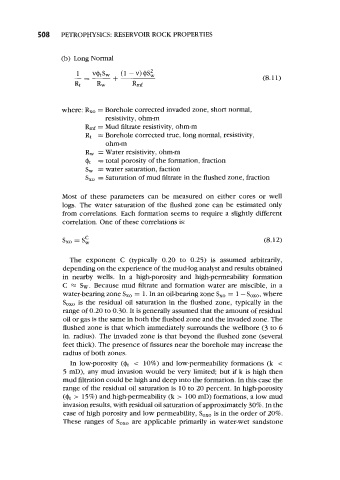Page 541 - Petrophysics
P. 541
508 PETROPHYSICS: RESERVOIR ROCK PROPERTIES
(b) LongNorma1
(8.11)
where: R,, = Borehole corrected invaded zone, short normal,
resistivity, ohm-m
Rmf = Mud filtrate resistivity, ohm-m
Rt = Borehole corrected true, long normal, resistivity,
ohm-m
Rw = Water resistivity, ohm-m
= total porosity of the formation, fraction
Qt
S, = water saturation, faction
Sxo = Saturation of mud filtrate in the flushed zone, fraction
Most of these parameters can be measured on either cores or well
logs. The water saturation of the flushed zone can be estimated only
from correlations. Each formation seems to require a slightly different
correlation. One of these correlations is:
s,, = s: (8.12)
The exponent C (typically 0.20 to 0.25) is assumed arbitrarily,
depending on the experience of the mud-log analyst and results obtained
in nearby wells. In a high-porosity and high-permeability formation
C x SW. Because mud filtrate and formation water are miscible, in a
water-bearing zone S,, = 1. In an oil-bearing zone S,, = 1 - Sox,, where
So,, is the residual oil saturation in the flushed zone, typically in the
range of 0.20 to 0.30. It is generally assumed that the amount of residual
oil or gas is the same in both the flushed zone and the invaded zone. The
flushed zone is that which immediately surrounds the wellbore (3 to 6
in. radius). The invaded zone is that beyond the flushed zone (several
feet thick). The presence of fissures near the borehole may increase the
radius of both zones.
In low-porosity ($t < 10%) and low-permeability formations (k <
5 mD), any mud invasion would be very limited; but if k is high then
mud filtration could be high and deep into the formation. In this case the
range of the residual oil saturation is 10 to 20 percent. In high-porosity
(Qt > 15%) and high-permeability (k > 100 mD) formations, a low mud
invasion results, with residual oil saturation of approximately 30%. In the
case of high porosity and low permeability, Sox, is in the order of 20%.
These ranges of So,, are applicable primarily in water-wet sandstone

